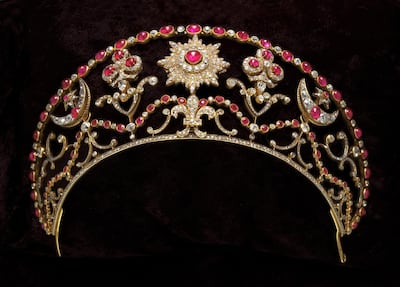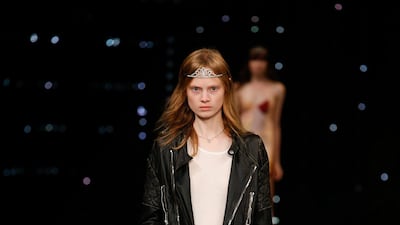A tiara is a jewelled crown that wraps around, but does not fully encase, the head – so while it is undeniably striking, it lacks regal significance. The metal base of the ornament is usually set with white diamonds and is designed so that the gems sit at level with the face of the wearer – all the better to allow refractions of light to illuminate one’s features.
The word tiara is interchangeable with diadem, and is thought to have originated from the Persian term for the high-peaked headdresses worn by kings. The ancient Greeks and Romans wore gold wreaths, while the Scythians of Iran wore headpieces that stood high above the head (and resurfaced as the inspiration for the headpiece worn by Natalie Portman in Star Wars).

By the late 18th century, the emergence of neoclassicism brought about a renewed fascination for tiaras, led by Empress Joséphine, the wife of Napoleon, who turned to Chaumet to design hers. Since 1780, the Paris-based high-end jewellery house has made more than 2,000 tiaras for royals and members of the aristocracy. As with all jewellery, the first step is to draw out a design, and Chaumet has an archive of more than 400,000 sketches, which draw inspirations from romanticism, naturalism and belle-époque and art deco styling. Although weight and balance are crucial for all jewellery, they are even more important when it comes to tiaras, particularly if the wearer needs to be able to dance without misplacing her gems. Today, Chaumet estimates that it takes 500 to 1,500 hours and up to six months to create a made-to-order piece. It's a multifaceted, entirely hand-crafted process, in which the tiara is first drawn out, then made into a volume model, then shaped, dismantled, engraved, assembled and finally polished.
The house of Cartier is another name that deserves a mention. In the late 19th century, founder Louis Cartier was inspired by the art nouveau movement to create fluid jewellery, pioneering the use of platinum, which was prized for its strength and flexibility. This enabled Cartier to use tiny, almost invisible settings that allowed light to play across more facets of each stone. Known as the garland, the style became a Cartier signature. For her wedding to Prince William in 2011, Kate Middleton wore a Cartier tiara dating back to 1936. Bought by King George VI as an anniversary gift for his wife, Elizabeth, it features close to 1,000 white diamonds and was presented to Queen Elizabeth II for her 18th birthday in 1944.
Interestingly, the Duchess of Cambridge has worn a tiara only a handful of times over the course of her royal duties. Another piece she's been spotted in was the property of Princess Margaret, the Queen's sister, called the Lotus or Papyrus tiara, and was once worn as a necklace by the Queen Mother. In 2017, Kate wore the Cambridge Lover's Knot, a piece created in 1913 by E Wolff & Co for Queen Mary, a consort of King George V. It was said to be one of Princess Diana's favourites.
Conventionally, the tiara worn by a bride on her wedding day would have come from her family's collection, before she moved on to wearing pieces owned by her husband's family. While Kate did not follow this tradition, Diana did. Even though she had been loaned the Lover's Knot tiara by Queen Elizabeth II, Diana wore her family's Spencer tiara for her marriage to Prince Charles in 1981. Composed of various pieces, the central part of the tiara was originally given to Diana's grandmother, Lady Cynthia Hamilton, at her wedding to the future 7th Earl Spencer, while the ends come from a piece that belonged to the last Viscountess of Montagu. The tiara took its present form in the 1930s, and in addition to being worn by Diana, it was also sported on the wedding days of both her sisters, and by her sister-in-law, Victoria Aitken, née Lockwood. Rumours abound that Meghan Markle will wear the Spencer tiara when she marries Diana's younger son later this year.
The tiara has not been restricted to royalty, however, and has often found favour among high-profile actresses as well. The Mike Todd tiara was originally created circa 1880, and was presented by producer Mike Todd to his wife Elizabeth Taylor in 1957, when his film Around the World in 80 Days won the Oscar for Best Picture. Made with nine mine-cut diamond scrolls and spaced with mine-cut latticework mounted on platinum and gold, it was sold at a Christie's auction in 2011, as part of the Collection of Elizabeth Taylor. Although estimated to fetch US$80,000 (Dh293,800), it sold for an astonishing $4.2 million (Dh15.4m).

Audrey Hepburn wore a small tiara with her Givenchy black dress in Breakfast at Tiffany's and again in Roman Holiday. Nicole Kidman wore one in the Baz Luhrmann film Moulin Rouge; Cate Blanchett wore several spectacular specimens for the Elizabeth films, designed by Alexandra Byrne. In 2013, Cartier made a replica of Princess Grace of Monaco's tiara for the film about her life. Elton John, not one to be left out, named his 1997 documentary Tantrums & Tiaras; and even Princess Aurora donned a golden headpiece in the 1959 Disney cartoon Sleeping Beauty.
The fashion crowd was not far behind, with labels such as Louis Vuitton, Rodarte and Miu Miu sending sparkling tiaras down runways. Of course, a handful of brands bent the rules as only fashion can do. Case in point: the grunge tiara made for spring 2016 by Saint Laurent, then led by fashion rebel Hedi Slimane, who wanted to create a crown inspired by the alternative rock music genre, and that could "be worn with anything".
_________________________
Read more:
Showbiz relationship splits we didn't see coming
Marvel hits back at early Inhumans criticism
Daniel Craig signed for two more Bond movies
__________________________



